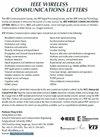面向低空经济的无人机联合部署与空时频资源配置
IF 5.5
3区 计算机科学
Q1 COMPUTER SCIENCE, INFORMATION SYSTEMS
引用次数: 0
摘要
这封信解决了联合无人驾驶飞行器(UAV)部署和空对地网络的空时频资源分配问题。从低空经济的角度出发,在降低资源消耗和运营成本的同时,为不同需求的不同用户提供高质量的服务,实现经济效益最大化。为了解决这种组合优化问题的高维复杂性,我们将不同类别的任务分解为单独的代理,并在集中训练和分布式执行的方法中利用多代理深度强化学习(MA-DRL)。此外,我们采用了一种关注机制来分析来自单个无人机的不同局部观测的异质效应,并生成特定于智能体的全局状态增强,从而进一步提高性能。仿真结果表明,该方案能够有效提高系统的经济效益,并优于目前最先进的典型DRL方法。本文章由计算机程序翻译,如有差异,请以英文原文为准。
Joint UAV Deployment and Space-Time-Frequency Resource Allocation for Low-Altitude Economy
This letter addresses a joint uncrewed aerial vehicle (UAV) deployment and space-time-frequency resource allocation problem for air-ground networks. From the perspective of low altitude economy, we aim to maximize the economic profit by delivering high-quality services to different users with diverse and varying requirements, while reducing resource consumption and operational costs. To address the high-dimensional complexity of this combinatorial optimization problem, we decompose different categories of tasks to separate agents and utilize multi-agent deep reinforcement learning (MA-DRL) in a centralized training and distributed execution approach. Furthermore, we employ an attention mechanism to analyze heterogeneous effects of different local observations from individual UAVs and generate agent-specific global state augmentations so that the performance is further improved. Simulation results demonstrate that the proposed scheme is effective in enhancing the economic profit, and outperforms typical state-of-the-art DRL approaches.
求助全文
通过发布文献求助,成功后即可免费获取论文全文。
去求助
来源期刊

IEEE Wireless Communications Letters
Engineering-Electrical and Electronic Engineering
CiteScore
12.30
自引率
6.30%
发文量
481
期刊介绍:
IEEE Wireless Communications Letters publishes short papers in a rapid publication cycle on advances in the state-of-the-art of wireless communications. Both theoretical contributions (including new techniques, concepts, and analyses) and practical contributions (including system experiments and prototypes, and new applications) are encouraged. This journal focuses on the physical layer and the link layer of wireless communication systems.
 求助内容:
求助内容: 应助结果提醒方式:
应助结果提醒方式:


